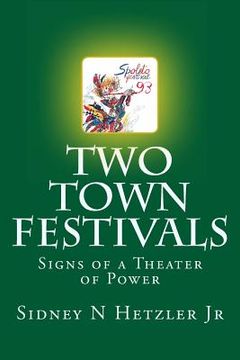Synopsis "two town festivals: signs of a theater of power (in English)"
Two Town Festivals really is two, if not three, books with old and new work in one unique format, which was made possible and affordable for cultural leaders, artists, scholars and educators by Amazon's print on demand technology. First, it opens with a interpretive foreword by thesis director Timothy J. Reiss (New York University professor emeritus, comparative literature) and a brief summarizing author's note. Second, it includes a vintage 1990 Emory dissertation (plus Chattanooga's 1980-82 untold stories of origin in the re-included, unpublished Appendix B), which, as a still valid historical book reflecting its time and place, offers a broad perspective of late 20th century cultural philosophy, flavored with vivid experiences of the creators of Charleston's Spoleto Festival USA and Chattanooga's Riverbend Festival. Third, it offers a 45-page afterword reflecting how these original insights into cultural practices of diversity and intolerance influenced the author's Split Tree participatory arts theater from 1990-2007 and also shaped his political philosophy about the unending struggle between what he sees as "difference" and "sameness." Festivals today are so commonplace that we seldom notice their subtle power to shape our shifting ideas about performing and participatory arts, ranging from Charleston's Spoleto Festival USA to Burning Man Festival, Black Rock, Nevada. Two Town Festivals raises questions about artists and art power, artistic directors or their absence, festival ideas and forms of difference and sameness. It primarily compares the town festivals created by Charleston, SC (Spoleto) and Chattanooga, TN (Riverbend) in the late 1970's and early 1980's, and contrasts them with ideas underlying the Chautauqua Institution, Salzburg Festival and other festive celebrations. It examines the deep political philosophies that influenced them, as well as their stories of origin and consequences, by offering "views," ways of seeing more than it suggests what to see, if you are standing in, experiencing and interpreting these theatrical "texts." Its conceptual foundations offer workable ways to see shaded meanings, such as masked, even deceptive, differences and false diversity. When you stand in your four-dimensional text of a festival, these views extend your thinking tools to make sense of the many signs and symbols addressed to you the festival creators, owners and sponsors who control these "theaters of power." The principle arguments are: 1) we shape our festivals; thereafter our festivals shape us; 2) most festivals provide a model for accepting differences and diversity in life, and we learn to tolerate as normal the small or large range of diversity contained within a festival's time and space; 3) in a festival's theatrical space the new and different, or traditional and sameness, are made visible, dramatizing the essential idea that "differences embrace sameness; sameness rejects difference." These claims are derived from analysis of three key signifiers: the festival's relationship to empty spaces (its place), its purposes (its ideal), and the presence or absence of an artistic director (its force). These three elements create a festival's degree of difference or sameness. They provide the study's conceptual design and suggest, in their interdependence, several conclusions about the nature, function, and meaning of these two festivals and festival philosophy in general. Why the special focus on Menotti? Spoleto designer Piero Lorenzini expresses his experience in a 2009 letter, "The Festival Affair": "Maestro Menotti was truly Spoleto's magician. He could change the physiognomy of the town, transform it into a crescendo of emotions and lead its inhabitants, its life and its stones into a dream-world...for 50 years." It is for this reason the book's cover image evoking Menotti as a Pied Piper was chosen.

